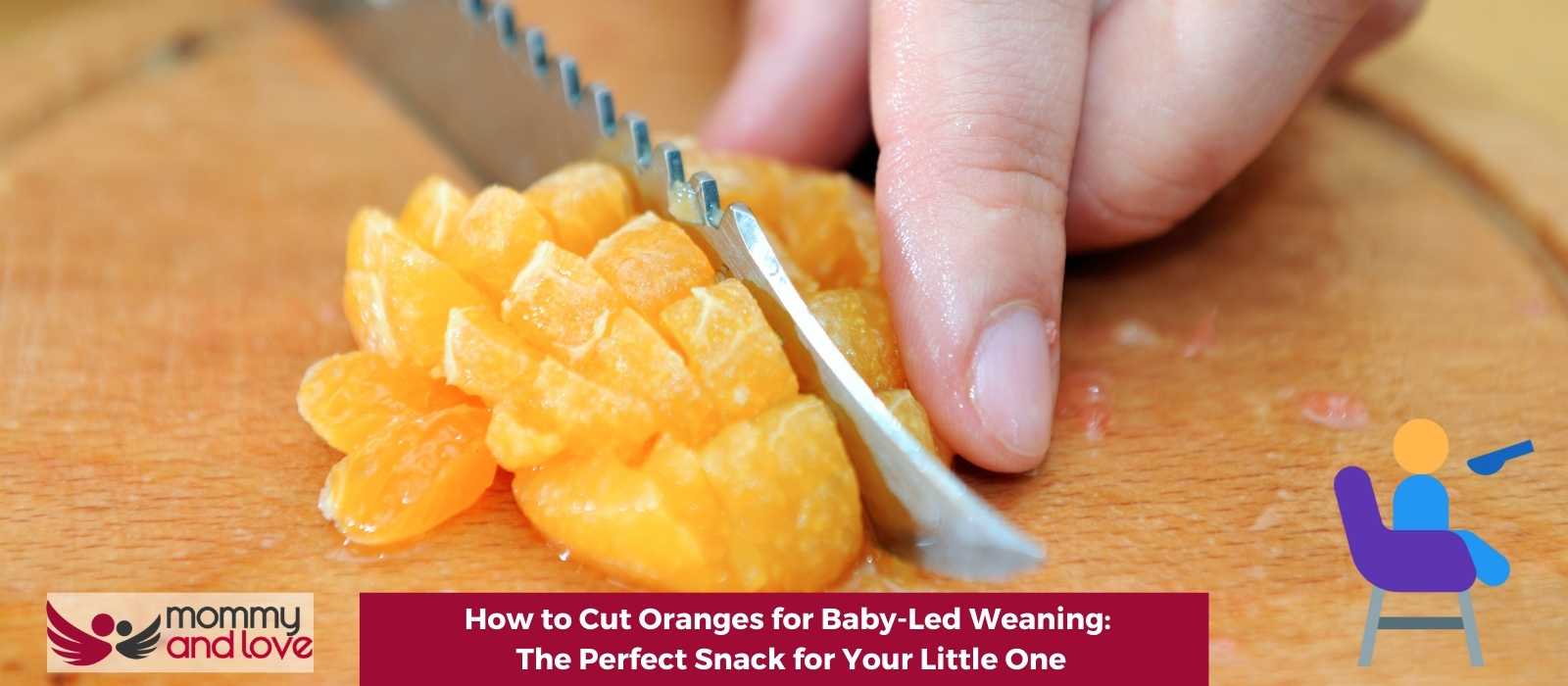When it comes to introducing your little one to solid foods, you want to give them the best possible experience. That’s why we’re going to show you how to cut oranges for your baby. This is a great way to introduce them to a variety of flavors and textures, and it’s easy to do. All you need is an orange and a sharp knife!
Are Oranges Healthy For Babies and Toddlers?
Oranges are citrus fruits and are a powerhouse of nutrients. It is an excellent source of vitamin C and some other vitamins. It is also loaded with minerals like potassium, magnesium, phosphorous and calcium. Plus, oranges are low in calories and fat, making them a perfect snack for your little one! And unlike bananas, they are pulpy.
Here are some reasons why you should include this yummy fruit in your kid’s diet:
Vitamin C for Healthy Immunity
This citrus fruit helps in improving immunity in babies and toddlers by providing them with vitamin C. Vitamin C helps in fighting infections and keeps the child healthy and happy always.
Good for Bones
Orange contains calcium which helps in building strong bones and teeth in kids. It is a good source of calcium too aside from breast milk.
Good for Eyesight

Vitamin A present in orange helps to keep the eyes healthy and improves eyesight. It also reduces the risk of developing night blindness later on in life.
Improves Digestion
Oranges are fiber-rich fruits that help in improving digestion in kids by regulating bowel movements. It also prevents constipation which is a common problem among kids. It should be given to babies suffering from diarrhea as it replenishes lost fluids through loose motions.
Here’s How to Properly Cut Oranges for Your Baby
Using this special sliced orange technique, you can properly serve oranges to your little one.
- Cut off one end of the orange, and then cut the other end off.
- Cut the orange wedges in half, lengthwise.
- Prepare oranges and peel them in halves, being careful to remove all of the white pith.
- Slice each orange segments half into thin wedges or into bite-sized pieces. Doing so, makes orange wedges easier to eat.
- Serve oranges as cut wedges to your little one and enjoy!
When Can Babies Eat Oranges?

So at what age can babies eat oranges? Oranges can be introduced to babies as early as six months old. And while you can introduce oranges anytime after 6 months, do so with caution.
This is usually the age when babies start eating finger foods. If you’re introducing oranges into your baby’s diet, start with a small amount and see how they tolerate it.
There is an orange-filled meal that you can give your children. Some of these meals would include adding purée sautéed carrots and other citrus fruit. And when your babies develop their pincer grasp, you can cut oranges into smaller pieces.
Can Babies Drink Orange Juice?
Yes, babies can drink fresh-squeezed orange juice! Just be sure to give them 100% pure juice with no added sugar. You can also water it down a bit if you’d like. Start with a small amount and see how your baby tolerates it. If they seem to be enjoying it, you can give them more. As always, consult with your pediatrician if you can give your child acidic fruits and before giving your baby any new finger foods.
How to Make Homemade Orange Juice for Your Baby
To make homemade juice for your baby, start by juicing a few oranges. You can then add water to thin it out if you’d like. If you want to sweeten the juice, you can add a bit of honey or sugar. However, keep in mind that babies under 12 months old should not have honey.
Is Orange a Common Allergen?
No, orange is not a common allergen. However, some babies can have an allergic reaction due to food allergies after eating citrus fruits, so always introduce oranges for babies slowly and watch for any signs of an allergic reaction.
Signs of a life-threatening allergic reaction include:
- hives and rashes around your baby’s mouth
- wheezing
- trouble breathing
- swelling of the face, lips, or tongue
- anaphylaxis
If you notice any of these signs after your baby eats oranges, stop giving your baby oranges and call your pediatrician immediately.
Are Oranges Choking Hazards for Babies?
Yes and no. Oranges themselves aren’t any more likely to be a choking hazard than any other fruit, but there are parts of oranges that could potentially cause problems if not prepared properly. The good news is that these aren’t eating oranges whole, but rather small pieces of orange, including seeds or citrus segments, that can be a choking risk.
What Are the Different Types of Oranges That Are Good for Babies?
There are many different types of oranges that are good for babies! Here are just a few:
Valencia Oranges
These oranges are great for juicing and eating fresh. They’re also perfect for self-feeding because they’re easy to slice into thin wedges.
Blood Oranges
Blood oranges have a beautiful reddish-pink flesh that is sure to intrigue your little one. They’re a bit more tart than other oranges, but still, make a delicious and healthy snack for babies.
Cara Cara Oranges
Cara Cara oranges are a type of blood orange with a slightly sweeter flavor.
Seville Oranges
Seville oranges are tart and acidic, making them perfect for marmalade. However, they can also be eaten fresh or juiced. Just be sure to introduce them slowly to your little one as they may be a bit too sour for some.
Mandarin Orange
Mandarin oranges are small, sweet, and easy to eat. They’re perfect for on-the-go snacking and make a great addition to your baby’s diet.
Tangelo Oranges
Tangelo oranges are a cross between grapefruit and tangerines. They have a slightly sweeter flavor than other citrus fruits, making them perfect for babies who enjoy a sweet treat.
No matter which type of orange you choose, your little one is sure to enjoy it! So go ahead and add this healthy and delicious fruit to their diet today.
How to Choose and Store Oranges for Your Baby
When choosing oranges for your baby, look for ones that are firm and have smooth skin. Avoid oranges that are bruised or have any blemishes. Once you’ve chosen your oranges, store them in a cool, dry place. Oranges will last up to two weeks when stored properly.
How to Make Orange Puree for Babies
If you’re looking to make orange puree for your baby, there are a few different ways you can do it. Here are just a few:
- Use a juicer to extract the juice from the oranges. You can then add water to thin it out if you’d like.
- Peel and chop the orange slice into small pieces. Add them to a blender or food processor along with a bit of water. Puree until smooth.
- Simply give your baby small pieces of peeled orange segment to eat. You can also cut the oranges into thin wedges for easy eating.
What Other Citrus Fruits to Pair Oranges With for Baby-Lead Weaning?
There are many different finger foods that go well with oranges. Here are just a few ideas for other fruits:
- Grapefruit
- Tangerines
- Lemons
- Limes
- Pineapple
- Mango
- Kiwi
- Strawberries
- Smushed or halved blueberries
Take Away
Oranges are a great fruit for baby-led weaning. They’re easy to eat and full of nutrients that are essential for your little one’s development. When choosing oranges for your baby, be sure to select ones that are firm and have smooth skin.
And when it comes to storing them, keep them in a cool, dry place. With so many different types of oranges to choose from, your baby is sure to find one they love. So go ahead and add this healthy and delicious fruit to their diet today!

This article was written by Sandra Baker – full time writer and the mother of four amazing kids (including twins!)
She’s also a breastfeeding counselor and has spent years helping new parents learn how to care for their children. When she’s not writing or caring for her children, Sandra likes to spend time reading and taking walks with her husband.




